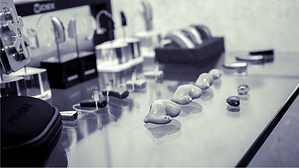“I’ve heard people say that it can help me sleep better at night, and also that it can help with Tinnitus in my ears! I have a friend who uses something to help him hear better too!”
When we’re sleeping, our brains continue to receive and process sounds and noises at a normal level. Noise can disturb or disrupt your sleep – possibly waking you up, causing you to toss and turn, meaning you have a restless or sleepless night. You could experience a change in heart rate and/or blood pressure – often so briefly that you don’t remember the next morning.
What level of sound can disrupt my sleep?
Whether sounds disturb your sleep depends on factors such as the stage of sleep you’re in, the time of night, and even your feelings about the sounds themselves.
It is most likely that noises wake you from light sleep (stages 1 and 2) than from deep sleep (stages 3 and 4), and they tend to be more disruptive in the second half of the night.
If you share a bed with someone, you will probably be aware of the variation in sensitivity to noise between the two of you. In fact, a recent study found that “sound sleepers” have characteristic brain activity that may make them more impervious to noise.
Interestingly enough, whether or not a sound disrupts your sleep depends in part on that sound’s personal meaning. Researchers have seen that people are more likely to wake when a sound is relevant or “emotionally charged”. This is why, for example, a parent could sleep soundly through her partner’s snores but wake fully when her baby fusses.
Helping babies to sleep
What can white noise be used for?
White noise works miraculously for babies who can’t settle down to sleep. The sound needed to turn on the “calming reflex” when a baby is crying is a rough, rumbly “whoosh” noise which is as loud as the crying itself. You can provide this sound by simply putting your mouth close to baby’s ear and making a long, loud “Ssshhhhh” sound.
***************************************************************************
Our online shop has several white noise products which will help with your tinnitus, settle you down or anyone else who struggles to sleep.
Have a look, but read the following summary before you decide what to get.
***************************************************************************
White Noise Machines
Recently, white noise machines have become much more popular in people’s homes and even in the workplace to mask noises and disturbances. This then allows users to get some much-needed sleep or give them more chance to focus on important work.
If you’re looking at purchasing a white noise machine, like any other purchase, we want to make sure we are getting something that is good value for money, does its job as expected and is reliable. Basically, we want to get the best device that’s on the market. It’s never fun to realise you purchased something of poor quality, or see something a few weeks later which has more features that would have been better suited to your needs.
- Non-looping – it’s not easy to replicate white noise or the noise of a fan, particularly not of any quality anyway. You can’t just record a simple noise and set it on a loop. It’s very likely that, although you won’t notice it initially, you will eventually clock on to where the loop starts and ends, or you may hear a particular noise and then realise it occurs every 30 seconds. You would find this so annoying and distracting, and for many users, it’s not something you want to focus on when you are trying to clear your mind and get some rest. The range of products available have microprocessors that process a number of tracks that dynamically generate a sound. When these tracks are combined, it creates a unique, non-looping, dynamically generated fan or white noise sound. It’s very clever stuff which has taken years of incremental development to get right.
- No moving parts – Many customers turn to white noise machines because they have been using a full-size fan in their bedroom for many years – producing white noise which has helped them get to sleep. However, by the time the winter comes, if the heating isn’t on full whack, the fan is simply too cold. Some manufacturers decided the best way to create a white noise machine is to get a traditional fan and shrink it down into a small box. There are major drawbacks to having a fan in a box. The first being the limited range of sound. At the end of the day, it can only oscillate at a different speed. The range of sound is going to be very limited and you might find that you just can’t find the right sound for you. It may be too sharp and harsh, or maybe it’s too boomy for your tastes. There are devices which have 10 separate fan sounds and 10 separate white noise sounds, you should be able to find the right sound for you. The biggest problem with a fan in a box is reliability.
- Reliable – So many things that have moving parts often break down. There are friction, heat and forces to worry about. A well designed and built circuit board can last indefinitely, but motors in a fan can start making a whirring noise, or the bearings in the fan start to go making a grinding or rattling noise, or dust starts to form on the fan and overheats it. If you have ever had a hairdryer break or your laptop gets very hot when it used to be ice cold? That’s probably because the fan is either caked in dust, or the motor has degraded performance. For a reliable white noise machine, it makes sense to stick to a well-designed circuit board and high-quality speaker. However, that’s not particularly easy. Unfortunately, with many low-end white noise machines, the speakers have always been incredibly tinny! This is due to low-quality components, which as we know are not going to be half as reliable as their high-quality counterparts. All it takes is for a cheap capacitor to pop or the low-quality speaker to tear and the machine is useless.



